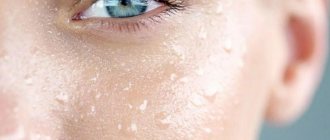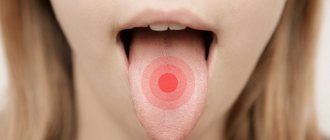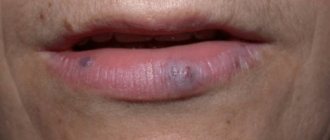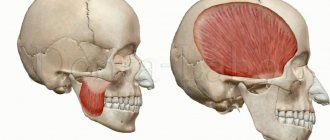Often you can meet people with an interesting facial expression: it is asymmetrical, as if distorted, emotionless, perhaps accompanied by small muscle twitches.
All these signs are united by a common name - facial neurosis. This condition can have a different nature of occurrence and is provoked by both objective reasons and factors of a psychogenic nature.
Unusual sensations
It happens that a person can feel phenomena in the face and head that are unusual for the usual state. They are called paresthesias and are manifested by the following symptoms:
- tingling;
- burning;
- "goosebumps"
- numbness;
- itching and rashes.
Often facial paresthesias have an organic basis and become a sign of the disease:
- neuritis, neuralgia of the cranial nerves;
- multiple sclerosis;
- stroke and other circulatory disorders in the brain;
- shingles;
- migraine;
- diabetes;
- epilepsy;
- hypertension.
In certain cases, unusual sensations are observed in certain parts of the face. For example, similar manifestations in the language may appear for the reasons listed above, but often have a different etiology. They are provoked by cancer of the tongue and larynx, as well as trauma by a splintered tooth or denture.
Dental procedures cause numbness and other unusual feelings, especially after tooth extraction. Another reason for their appearance may be an uncomfortable position during sleep or an unsuitable pillow. But the sensations caused by such phenomena usually pass soon.
Another group of provoking factors consists of psychogenic and neurogenic disorders.
Disorders of facial innervation
A neurotic face may develop due to damage to the nerves that innervate it. Most often these are the trigeminal and facial nerves.
The trigeminal nerve is the 5th pair of cranial nerves. It is the largest of all 12 pairs of these nerve fibers.
N. trigeminus arises symmetrically on both sides of the face and consists of 3 large branches: the ophthalmic, maxillary and mandibular nerves. These three large processes innervate a fairly large area:
- skin of the forehead and temples;
- mucous membrane of the oral and nasal cavities, sinuses;
- tongue, teeth, conjunctiva;
- muscles - chewing, floor of the mouth, palatine, tympanic membrane.
Accordingly, when it is damaged, pathological sensations arise in these elements.
Facial nerve – 7th pair of cranial nerves. Its branches surround the temporal and ocular region, the zygomatic arch, and descend to and behind the lower jaw. They innervate all facial muscles: auricular, orbicularis and zygomatic, chewing, upper lip and corners of the mouth, cheek. As well as the muscles of the lower lip and chin, around the mouth, the muscles of the nose and laughter, and the neck.
N. facialis is also paired, and is located on both sides of the face.
In 94% of cases, the damage to these nerve fibers is unilateral, and only 6% is a bilateral process.
Disruption of innervation can also be primary or secondary.
Primary is the lesion that initially involves the nerve. This could be hypothermia or strangulation.
Secondary damage develops as a consequence of other diseases.
Another reason for the development of facial neurosis is neurogenic and mental disorders. When unpleasant sensations in the face and head occur against the background of psycho-emotional arousal, shock, or as a result of stressful situations.
Facial nerve neurosis
Neuritis (neurosis N. Facialis) or Bell's palsy occurs due to inflammation of the nerve fiber. Reasons leading to this condition:
- pinched nerve as a result of narrowing of the channel through which it passes. This may be a congenital phenomenon or result from inflammation;
- hypothermia;
- other diseases and infections: herpes, mumps, otitis media, stroke, cancer, central nervous system infections;
- injury N. Facialis.
The onset of the disease is usually gradual. Manifested by pain in the behind-the-ear area. After a couple of days, neurological facial symptoms appear:
- smoothing of the nasolabial fold, drooping of the corner of the mouth;
- the face becomes asymmetrical with a skew towards the healthy side;
- eyelids do not droop. When you try to do this, your eye rolls;
- any attempt to show at least some emotion ends in failure, since the patient cannot move his lips, smile, or manipulate his eyebrows. Such manifestations can worsen to the point of paresis and paralysis of the facial muscles, that is, to partial or complete immobility of the affected part of the face;
- taste sensitivity decreases, salivation appears;
- the eyes are dry, but there is lacrimation when eating;
- hearing on the affected side worsens.
The severity of pathological symptoms depends on the degree and area of damage to the nerve fiber. If the disease is treated inadequately, complications may arise in the form of muscle contractures (immobility).
Since the disease is inflammatory in nature, its treatment is aimed at eliminating it. For this, the patient is prescribed hormonal anti-inflammatory drugs - glucocorticoids, as well as decongestants.
Other methods include:
- prescription of vasodilators and analgesics, B vitamins;
- anticholinesterase agents to increase nerve conduction;
- drugs that improve metabolism in nervous tissue;
- physiotherapy;
- massage, exercise therapy in the recovery stage.
And only in extreme cases, when conservative therapy is ineffective, neurosurgical intervention is resorted to.
Treatment
If numbness of the lips and tongue is observed with cervical osteochondrosis, it is treated with medications, and also includes massage and physical therapy. Regarding this condition with neuritis, the therapeutic course includes: glucocorticoids, vasodilators, vitamins. When such a phenomenon is observed in viral diseases, treatment of the underlying pathology is mandatory.
Multiple sclerosis, which causes numbness of the lips and tongue, is treated with hormone therapy, immunomodulators, and some other drugs. This therapy allows you to cope with this disease and remove numbness.
Allergies can also cause the above condition. In this case, the allergen is determined; for the most part, food products and some medications can cause an allergic reaction. In parallel with this, antihistamines are prescribed.
It must be remembered that almost always numbness of the lips and tongue appears against the background of some ailment, so it is necessary to initially treat the underlying disease.
Numbness of the tongue and lips at first glance seems like a minor problem. But, having found out why this can happen, and if it concerns certain diseases, you should seek medical help, where they will help make an accurate diagnosis and prescribe the correct treatment.
Trigeminal neuralgia
This is another lesion of the nerve fiber structure, which is often chronic and accompanied by periods of exacerbation and remission.
It has several causes, which are divided into idiopathic - when a nerve is pinched, and symptomatic.
The main symptom of neuralgia is paroxysmal sensations in the form of pain on the face and in the mouth.
Pain sensations have characteristic differences. They are “shooting” and resemble an electric shock; they arise in those parts that are innervated by the n.trigeminus. Having appeared once in one place, they do not change localization, but spread to other areas, each time following a clear, monotonous trajectory.
The nature of the pain is paroxysmal, lasting up to 2 minutes. At its height, a muscle tic is observed, that is, small twitching of the facial muscles. At this moment, the patient has a peculiar appearance: he seems to freeze, but does not cry, does not scream, and his face is not distorted from pain. He tries to make a minimum of movements, since any of them increases the pain. After the attack there is a period of calm.
Such a person performs the act of chewing only with the healthy side, at any time. Because of this, compaction or muscle atrophy develops in the affected area.
The symptoms of the disease are quite specific, and its diagnosis is not difficult.
Therapy for neuralgia begins with taking anticonvulsants, which form its basis. Their dose is subject to strict regulation and is prescribed according to a specific scheme. Representatives of this pharmacological group can reduce agitation and the degree of sensitivity to painful stimuli. And, therefore, reduce pain. Thanks to this, patients have the opportunity to freely eat and talk.
Physiotherapy is also used. If this treatment does not give the desired result, proceed to surgery.
Diagnosis and treatment
Numbness of the lips itself occurs only for physiological reasons and does not require treatment. In other cases, patients note other signs of pathology: pain, weakness, dizziness, etc. Based on these, the cause of the sensitivity disorder can be determined and a treatment regimen can be selected. To make an accurate diagnosis, you need to consult a therapist, dentist or neurologist.
If inflammatory processes or tumors in the oral cavity are suspected, an x-ray is prescribed.
For neurological pathologies, CT and MRI are used to make a diagnosis. Laboratory tests help confirm or exclude the presence of diabetes and anemia. To get rid of numb lips, you need to eliminate the underlying cause. To do this, patients are prescribed drug therapy that effectively combats the symptoms of the disease. For tumors, fractures or injuries of the jaw, pulpitis, abscesses, and strokes, surgical treatment is required.
Real life examples
Some famous people, whose fame sometimes trumpets all over the world, were also hostage to the pathology of the facial nerve.
Sylvester Stallone, who is known for his enchanting roles, was injured at birth. The actor's mother had a difficult birth and he had to be pulled with forceps. The result is damage to the vocal cords and paresis of the left side of the face. Because of this, Stallone had problems with speech, which became a reason for ridicule from his peers.
The actor grew up as a difficult child. But, in spite of everything, he managed to overcome his defect and achieve considerable success, although partial immobility of his face remained.
Domestic showman Dmitry Nagiyev received facial asymmetry, which was nicknamed “Nagiyev’s squint”, due to paresis of the facial nerve. The illness happened unexpectedly. As a theater student, one day he felt that his face was not moving.
He spent 1.5 months in the hospital to no avail. But one day in his room a window broke due to a draft. Fright provoked a partial return of mobility and sensitivity of the facial part, but the left part retained its immobility.
Migraine
This condition is accompanied by attacks of unbearable headache. It is also associated with disruption of the trigeminal nerve, or more precisely, with its irritation in one part of the head. This is where the pain is subsequently localized.
The onset of migraine includes several stages:
- initial;
- aura;
- painful;
- final one.
Paresthesia of the head and face appears with the development of the aura stage. In this case, the patient is bothered by a feeling of tingling and crawling, which occurs in the arm and gradually moves to the neck and head. The person’s face becomes numb and it becomes difficult for him to speak. I am concerned about dizziness and visual disturbances in the form of light flashes, floaters and a decrease in the field of vision.
Facial paresthesia is a precursor to migraine, but often the attack occurs without the aura stage.
Causes
Carpal tunnel syndrome
Carpal tunnel syndrome is compression of the median nerve in the hand area, where the median nerve runs in an anatomically narrow place along with the tendons and is covered by the retinaculum ligament.
How does it manifest?
The hands begin to go numb at night, the person is forced to wake up from this numbness and shake his hands. Gradually, this condition becomes more frequent, then the fingers begin to go numb during the day during any movements with the hands. In advanced stages, weakness in the hand appears and the person cannot hold various objects. Most often, carpal tunnel syndrome develops in people who constantly work with their hands: office workers, massage therapists, workers.
Cubital tunnel syndrome
Cubital tunnel syndrome is compression of the ulnar nerve in the area of the elbow, where we feel pain and shooting along the nerve when we hit the elbow (inside), which everyone has experienced at some point.
How does it manifest?
The first symptom is the little finger going numb. Then weakness appears in the fingers (ring, little finger), and it becomes difficult to hold objects. Hand atrophy may occur. Numbness most often occurs during the day, while working with your hands or when lifting your hands. Men get sick more often than women.
Anterior scalene syndrome
Anterior scalene syndrome is compression of the brachial plexus in the interscalene space in the neck (between the anterior and middle scalene muscles).
How does it manifest?
The symptoms are the same: numbness in the little finger and ring finger, then weakness in the hand. Occupational complication: for example, occurs in musicians who play the violin for a long time for several hours. Or at hairdressers during a long haircut in a static neck position.
Radiculopathy
Radiculopathy is compression of the spinal roots. The cause, as a rule, lies in a herniated disc. There are 3 roots going to the fingers: C6, C7, C8. Radiculopathy of the C6 root is more common.
How does it manifest?
The first symptoms are numbness in the thumb and index finger. Radiculopathy is usually accompanied by pain in the neck and radiating to the arm. Numbness in the fingers intensifies with any movements in the neck.
Psychogenic causes of facial neurosis
Undoubtedly, disturbances in facial sensations quite often become a consequence of pathology of internal organs and blood vessels.
But often they are caused by psychological disorders and pathological thoughts that arise in our heads.
Facial paresthesias can be situational in nature and develop during episodic nervous excitement: as a result of quarrels, prolonged and intense screams. Such phenomena cause overstrain of the muscles, especially the cheeks and those located around the mouth. As a result, we experience facial numbness and even mild soreness.
The feeling of fear causes us to breathe quickly and shallowly, or to hold our breath. Disturbances in the respiratory rhythm can also provoke impressions that are atypical for us. A feeling arises that is characterized as a “chill running through.” Moreover, it is more concentrated at the roots of the hair. In this case they say: “chills to the marrow of the bones.” The face also becomes cold, a slight tingling appears in its area.
Such phenomena are disturbing when we are overwhelmed by strong emotions. But they accompany people suffering from mental disorders systematically.
A special type of neurotic facial manifestations is a nervous tic. It is characterized as an uncontrolled and systematic contraction of the facial muscles.
The disorder more often accompanies men. And it manifests itself with the following symptoms:
1.Motor:
- frequent blinking, winking;
- setting the lips with a tube;
- nodding head;
- constant spitting or sniffing;
- opening or upturning of the corner of the mouth;
- wrinkling of the nose.
2. Vocal:
- screaming;
- grunt;
- coughing;
- repetition of words.
There are also signs – precursors – that signal the appearance of a tic.
These include itching, facial heat and other paresthesias. Naturally, these signs are considered pathological if they occur in an inappropriate situation. It happens that only the patient himself feels them, but they are not visible to others.
But often twitching and other nervous symptoms become noticeable by other people, and they cause a lot of discomfort to the patient.
Tics can be simple, when there is only one symptom, or complex, which combines several manifestations.
The most common, main cause of tics is mental stress. It can be caused by a strong stress factor of one-stage action. Perhaps you were very scared of something, or broke up with your loved one. That is, the shock was so strong for you that your nervous system lost control.
Or, on the contrary, disorders develop as a result of prolonged monotonous exposure. Symptoms often appear due to lack of sleep and overwork.
Their duration varies. A situational nervous tic disappears a few hours or days after the cause is eliminated. In another case, it persists for years or haunts the patient throughout his life. In such a situation, in addition to eliminating the provoking factor, subsequent psychological work with the patient is required. This type of disorder is called chronic.
A nervous tic can be one of the signs of mental disorders such as neurosis, obsessive thoughts and phobias, depression.
Another group of provoking factors include:
- diseases - stroke, brain injury, infections or poisons;
- neurodegenerative diseases - Huntington's chorea. Characterized by destruction of brain tissue. Accompanied by uncoordinated, sudden movements, as well as neurological disorders of the face. Of these, the first sign is slow eye movements. Then a muscle spasm of the face occurs, which manifests itself in grotesque facial expressions - grimacing. Speech, chewing and swallowing are impaired;
- burdened heredity;
- parasitic infestations;
- eye fatigue due to prolonged eye strain;
- unbalanced diet, when the body receives little magnesium, calcium, glycine. These elements participate in the normal conduction of nerve impulses and are responsible for the coordinated functioning of the nervous system.
Causes of tongue tingling
Physiological factors
Tingling, burning throughout the tongue occurs after eating spicy foods and some spices.
Unpleasant sensations occur directly during eating and last for several hours. To reduce discomfort, a person drinks cool water and rinses his mouth. The tingling sensation is accompanied by increased production of saliva, which must be constantly swallowed. Externally, the tongue is unchanged, sometimes due to irritation and increased blood flow, it looks bright pink. The second typical reason is drinking too hot drinks or food. A superficial burn of the tongue occurs, which manifests itself as painful tingling, burning and tingling. With mild damage, symptoms persist for 12-24 hours, after which increased sensitivity of receptors to hot or spicy foods persists for several days.
Dental diseases
Constant tingling occurs when the tongue is traumatized by the sharp edges of carious teeth, incorrectly selected crowns or dentures. Discomfort is felt in the same place where maximum friction or scratching of the tooth on the surface of the tongue occurs. An epithelial defect is formed in this area, so when spicy food enters, the tingling intensifies.
Xerostomia
Low saliva production causes the tongue to dry out, which results in a painful feeling of tightness and tingling. Symptoms are aggravated by talking for a long time or eating dry solid food. Gradually, xerostomia progresses, so burning, tingling, and discomfort persist constantly. To alleviate the condition, patients regularly rinse their mouths and drink water, but such manipulations only help for a short time.
Tingling tongue
Glossalgia
With this pathology, the patient complains of a variety of painful sensations: tingling, pinching, rawness. Symptoms are not associated with ingestion of food or hot drinks. The tingling sensation is most pronounced on the lateral surfaces and tip of the tongue. The localization of sensations changes periodically. Externally the language has not been changed. Secondary glossalgias are manifested by:
- Endocrine disorders
: diabetes mellitus, Cushing's disease, hypothyroidism. - Gastrointestinal pathologies
: gastritis and gastroduodenitis, pancreatitis, hepatitis and cholecystitis. - Damage to peripheral nerves
: neuropathy of the glossopharyngeal nerve, ganglionitis of the sublingual autonomic ganglion, sympathalgia. - Diseases of the central nervous system
: encephalitis, neurosyphilis, residual effects after a stroke. - Connective tissue diseases
: scleroderma, dermatomyositis.
Glossodynia
Paresthesias are observed, manifested by tingling, burning, and a sensation of “crawling goosebumps” that have no apparent cause. At first, the discomfort symptoms affect only the tip of the tongue, but gradually they spread over its entire surface like an “oil stain.” The root of the tongue is the last to be affected, but often no tingling occurs in this area at all.
Discomfortable sensations last for 3-5 minutes and appear several times a day. As glossodynia progresses, episodes of paresthesia lengthen and are accompanied by a feeling of enlargement and swelling of the tongue. The pathognomonic feature of the disease is the absence of tingling at the time of eating. Therefore, people constantly chew something, which ultimately leads to weight gain and dental caries.
Desquamative glossitis
Periodically during the day, patients experience an unpleasant tingling and burning sensation in the mouth. Tingling spreads over the entire surface of the tongue or to its individual areas that are affected by the inflammatory process. It is common to experience increased discomfort while eating, especially when eating hot or spicy foods. Symptoms bother the patient for several weeks or months.
With desquamative glossitis, unlike glossalgia and glossodynia, the appearance of the tongue changes. Bright red foci of inflammation appear on its mucosa with detachment of the epithelium, noticeable cracks or furrows form. In areas of desquamation, pain and tingling are most pronounced. The wounds heal quickly, then new erosions form elsewhere - an ever-changing “geographic pattern” on the tongue.
Hypovitaminosis B12
Tingling and pinching of the tongue is caused by atrophy of the papillae and the development of Gunter's glossitis. Discomfort is observed constantly, it is not associated with food or other external factors. With increasing deficiency of vitamin B 12 and the occurrence of macrocytic anemia, the symptoms worsen. Patients complain of a constant painful burning sensation and pain when eating. The tongue becomes bright red, “polished” and shiny.
Oral candidiasis
Tingling of the tongue is characteristic of chronic candidiasis, while in the acute form, severe burning and pain are more common. The feeling of discomfort extends not only to the back of the tongue, but also to the mucous membrane of the cheeks and the red border of the lips. Patients notice a thick grayish plaque, after peeling it off, bright red inflamed areas of the epithelium remain. With the development of chronic atrophic candidiasis, tingling is complemented by severe dry mouth.
Allergy
Paresthesia in the tongue is one of the signs of a food allergy or reaction to animal fur or plant pollen. In this case, the tingling is combined with painful itching, to relieve which patients try to “scratch” the back of the tongue with their teeth, which increases the discomfort. Symptoms appear against the background of other allergic manifestations: lacrimation, sneezing, digestive disorders.
Nervous tics in children
There are several types of such disorders in childhood.
Transient tic disorder begins to manifest itself during early school age. Its duration ranges from 1 month to 1 year. Motor types of tics occur more often. Mainly typical for children with developmental delays and autism.
Chronic disorder occurs before age 18. And lasts from 1 year and above. In this case, either motor or vocal tics develop. The earlier the pathological symptoms appear, the easier and faster they pass.
Tourette syndrome is a multiple tic disorder characterized by both motor and movement types. A serious disease, which, however, softens with age.
A special type of disease, which is also characterized by signs of the nervous type, is minor chorea. It develops against the background of infections caused by streptococcus: sore throat, tonsillitis, rheumatism. Accompanied by pathological changes in nervous tissue.
Along with hyperkinesis, emotional instability, irritation, restlessness and anxiety, this condition corresponds to neurotic changes in the face. They are expressed in tension and spasms of the facial muscles, which is often mistaken for grimacing. There is also a spasm of the larynx, manifested in inappropriate screams.
At school, such children, not knowing the true cause of facial hyperkinesis, and even in combination with increased activity, are reprimanded and kicked out of class. Such an attitude towards the child forces him to miss school classes and avoid going to school. Treatment for chorea minor, along with sedatives, includes antibiotics to fight infection and anti-inflammatory drugs.
A nervous tic leaves a heavier imprint on a child’s psyche than on an adult. It often causes anxiety and detachment, withdrawal, and even provokes depressive disorders. Causes sleep disturbances, speech difficulties, and learning difficulties.
Tic disorders lead to distorted self-perception and decreased self-esteem.
Parents of such children are advised not to focus the child’s attention on the problem. On the contrary, they recommend finding ways to shift attention and increase self-esteem. A special place is given to support groups for such people and communication in general.
Why do my fingers go numb?
Physiological reasons
In a healthy person, numbness in the fingers occurs due to prolonged exposure to an uncomfortable position, caused by compression of blood vessels, and local circulation disorders.
The symptom appears when waking up after sleep with a hand placed under the pillow or under the head. It can be observed when resting on your back with your arms behind your head. Combined with tingling, feeling of “disobedience” of the hand. It goes away on its own within 5-10 minutes. Another reason for numbness in the fingers is prolonged exposure to the cold. The decrease in sensitivity is caused by vasospasm and may be accompanied by aching pain. It is considered a sign indicating the possibility of developing frostbite in the absence of warming measures.
Neuropathies
Numbness is one of the first symptoms of neuropathy. In the initial stages it appears periodically, accompanied by a feeling of tingling, “crawling goosebumps”. Subsequently, hypoesthesia becomes permanent, accompanied by pain, muscle weakness, changes in the skin and soft tissues. The area of numbness is determined by the affected nerve:
- Radial nerve neuropathy.
When the nerve trunk is involved in the upper third of the shoulder, sensitivity in the area of 1, 2, and partially 3 fingers is impaired. When affected at the level of the forearm, hypoesthesia occurs only on the back of the fingers. - Ulnar nerve neuropathy.
On the palmar surface, the little finger and half of the ring finger are numb, on the back - half of the 3rd finger, completely 4-5 fingers. - Median nerve neuropathy.
On the palmar side, numbness appears in the 1st-3rd and half of the 4th fingers; on the dorsal side, sensitivity decreases in the area of the nail phalanges of the 2nd-5th fingers. - Carpal tunnel syndrome.
Damage to the median nerve due to compression in a narrow bone canal is manifested by numbness of 1-3 fingers.
Polyneuropathy
Multiple neuropathies occur in some rheumatic and oncological diseases, severe kidney and liver diseases. They can be provoked by severe infectious processes, occupational hazards, and exogenous intoxications. There is symmetrical involvement of the limbs. The causes of numbness are:
- chronic inflammatory demyelinating polyneuropathy;
- neural amyotrophy of Charcot-Marie-Tooth;
- Roussy-Lévy syndrome;
- Refsum's disease;
- alcoholic polyneuropathy;
- polyneuropathy of pregnancy;
- neuroacancytosis;
- neuroAIDS;
- polyneuropathy with systemic vasculitis.
Numbness of fingers
Diabetes
Diabetic neuropathy is a special case of polyneuropathy. Can be diagnosed in patients with any form of diabetes. The likelihood of developing neuropathy depends on the duration and severity of the underlying disease. The pathology is manifested by numbness, burning, tingling, pain, short-term cramps, distorted perception of temperature and tactile stimuli, and muscle weakness. The hands suffer less than the feet.
Other neurological pathologies
Numbness of the fingers is included in the clinical picture, but, as a rule, is not a leading symptom in the following diseases:
- Cervical plexitis.
Develops with osteochondrosis of the spine, intervertebral hernia. It becomes a consequence of birth trauma, fractures, bruises and subluxations of the cervical spine, and some infectious diseases (sore throat, flu, tuberculosis). It is formed due to compression of the nerve plexus by a cervical rib or enlarged lymph nodes. - Brachial plexitis.
The causes of damage to the brachial plexus are injuries to the clavicle and shoulder joint, compression by lymph nodes, aneurysm or tumor, compression in bedridden patients and people using crutches, infectious, dysmetabolic diseases. - Horner's syndrome.
Damage to sympathetic nerve fibers occurs against the background of brachial plexus blockade, improper drainage placement, Pancoast cancer, aortic aneurysm, multiple sclerosis, otitis media, and thyroid diseases.
Persistent numbness of the fingers may be a consequence of damage to the spinal cord and brain due to spinal cord injury, head injury or hemorrhage. Other possible provoking factors are malignant and benign brain tumors, neurorheumatism. Short-term hypoesthesia occurs in the presyncope period in patients with neurocardiogenic syncope.
Raynaud's syndrome
Paroxysmal ischemia of the hands in typical cases is most clearly manifested in the area of 2 and 4 fingers. First, there is numbness, coldness and paleness of the fingers, then - swelling, burning, aching pain. The attack ends with a feeling of heat and sharp redness of the fingers. Raynaud's syndrome is detected in the following cases:
- Rheumatic diseases
: SLE, scleroderma, rheumatoid arthritis, systemic vasculitis. - Neurological pathologies
: diencephalic disorders, damage to the sympathetic ganglia, compression of the neurovascular bundles. - Other conditions
: hematological and endocrine diseases, systematic hypothermia, vibration disease.
Traumatic injuries
Short-term numbness of the hand is possible with any injury accompanied by significant swelling of the limb; it develops against the background of vascular compression. Loss of sensitivity in combination with intense pain that is not relieved by non-narcotic analgesics indicates the development of a serious complication - myofascial compartment syndrome, which requires urgent medical attention to preserve the viability of the limb.
A special case of compression due to injury is the increase in swelling in the first days after fixing the arm in a plaster cast. The fingers become numb, turn blue, and become sausage-shaped due to swelling. The patient complains of strong pressure from the cast. The symptom disappears after loosening the bandage, which should be done in a trauma room.
In case of wounds with a violation of the integrity of the nerve trunks, numbness of the fingers develops immediately after the injury and is combined with movement disorders. The area of loss of sensitivity corresponds to the area of hypoesthesia with neuropathy of the corresponding nerve.
Other reasons
Diseases and pathological conditions accompanied by numbness of the fingers include:
- Hypertonic disease.
The symptom appears with a persistent increase in systolic pressure above 140-160 mmHg. Art., combined with swelling of the hands, redness of the face, sweating, and prolonged pain in the heart area. - Anemia.
Hypoesthesia of the fingers is complemented by malaise, weakness, fatigue, shortness of breath, palpitations, headache, and impaired concentration. Dizziness and fainting are possible. - Lack of vitamins.
Vitamin B1 deficiency in the peripheral form of beriberi is manifested by weakness, numbness of the feet and hands, and difficulty in minor operations requiring fine movements of the fingers. Lack of B12 provokes peripheral neuropathy. - Takayasu's disease.
Numbness of the fingers with nonspecific aortoarteritis is potentiated by ischemia of the upper extremities. Sensory disturbances are complemented by coldness, absence or weakening of the pulse in the arteries of the limb. - Dercum's disease.
Multiple lipomas compress the cutaneous branches of the peripheral nerves, resulting in pain, numbness of the fingers, and impaired fine motor skills. - Mental disorders
. Temporary numbness of the fingers (more often paroxysmal) is observed with panic attacks, phobic disorders, and hysterical neurosis. Sometimes it is combined with tremor, coldness, and a feeling of crawling goosebumps.
How to get rid of nervous tics
In order to free yourself from unpleasant sensations, you must first eliminate their problem. Sometimes all it takes is a good night's sleep. In another case, you need to change the situation for a while, get out of the destructive environment.
Among the auxiliary methods used are herbal soothing teas, baths with the addition of aromatic oils, swimming, walks in the fresh air or sports: running, yoga.
Add ingredients with a high content of calcium and magnesium to your menu. These include fermented milk products, buckwheat, bran bread, red fish, eggs, and meat. Vegetables and fruits include beets, currants, dried fruits, nuts and parsley.
If these foods do not fit into your diet, consider taking appropriate vitamin supplements. Do not overuse strong tea and coffee.
And most importantly: remain optimistic and calm in any situation!
In cases where the condition worsens, psychotherapy is sought. Cognitive behavioral therapy is especially effective in helping to stop tic disorders at the stage of their precursors.
Habit reversal therapy teaches patients movements that help prevent the development of neurological facial symptoms.
Medications include anticonvulsants and muscle relaxants, Botox injections, and antidepressants.
If the above methods are ineffective in combating nervous tics, they turn to deep brain stimulation. A device is installed in the GM that controls electrical impulses.
How to remove teak yourself
If a nervous facial tic is situational and is not too intense, but at the same time obsessive, you can try to get rid of it using physical methods.
One way is to try to disrupt the pathological muscle rhythm by overexerting it. For example, if your eye twitches, try to close your eyes tightly.
It is possible to calm an overexcited muscle through a light massage. Or apply cold to it. The temperature difference will also help. Wash your face alternately with cold and warm water.
Other causes of numbness
If your arms and legs are numb on both sides, then perhaps the spinal cord is being compressed due to a tumor, injury, hematoma, abscess (abscess), or it is a matter of peripheral polyneuropathy - damage to small peripheral nerves or disruption of their function. It is usually caused by certain medications, diabetes, chronic kidney disease, vitamin B12 deficiency, Lyme disease, or HIV infection. Most drugs that cause numbness include chemotherapy. As a rule, some time after the end of chemotherapy, sensitivity returns.
Diabetic neuropathy is a fairly common occurrence in patients with diabetes. The exact cause of the damage is unknown, but it is believed that metabolic disorders and destruction of small vessels occur, which leads to nerve damage. If numbness has already occurred, it is impossible to completely get rid of it. But the condition can improve if you monitor your blood sugar levels more closely. If the numbness is significant, then you need to follow the doctor’s recommendations to avoid injury to the limbs and subsequent complications.
Exactly how vitamin B12 deficiency disrupts the formation of myelin sheaths on nerves is unknown. But if this substance is not enough, then the legs, rather than the arms, often go numb. Also, a lack of vitamin B12 is accompanied by anemia and weakness. But numbness occurs only with a very serious deficiency. With treatment, symptoms go away within 3 months; in severe cases, recovery can take a year.
When chronic kidney disease worsens, uremia occurs—products of nitrogen metabolism and other toxic substances accumulate in the blood. This leads to peripheral nerve damage and numbness. This condition (uremic polyneuropathy) is an indication for dialysis or kidney transplantation.
Lyme disease and HIV infection can cause inflammation of some parts of the nervous system. With Lyme disease, numbness does not appear immediately, but already against the background of a flu-like state, from which the disease begins. Lyme disease is treated with antibiotics.
With HIV infection, numbness often occurs due to the fact that a weakened immune system allows the development of a cytomegalovirus infection, which affects the nerve fibers. Numbness usually occurs in people who are not taking antiretroviral therapy, which can greatly improve the condition of a person with HIV. Therefore, in order for the numbness to go away, you need to start specific treatment as early as possible.
Numbness and osteochondrosis
Why is osteochondrosis not on this list? The fact is that this diagnosis is not known anywhere except in the countries of the former Soviet Union. Usually they blame him for everything that they cannot explain. Degenerative changes in the spine are normal for anyone over 40 years of age. Numbness has other, real causes that can often be dealt with. Therefore, if you are diagnosed with osteochondrosis, you should consult another specialist.
Dermatillomania
Neurosis of the face and scalp can manifest itself in a behavioral disorder such as dermatillomania.
Its main manifestation is scratching the skin of the face and head, not because of itching, but because of dissatisfaction with its appearance. This also includes an obsessive zeal to squeeze out pimples, scratch off scabs, and pull out hair. Self-injurious actions cause a short-term feeling of pleasure, followed by feelings of shame, frustration, and dissatisfaction.
The face of such patients is covered with scars and scars due to constant trauma to the skin. This process is uncontrollable and can occur at any time of the day. But most often traumatic actions are carried out in front of a mirror.
Symptoms of the disorder also include the habit of biting the lips and mucous membranes of the cheeks. Patients are not deterred by the prospect of redness, bleeding, and scarring of the skin. They repeat the ritual day after day. It lasts from a few minutes to an hour.
Such actions can be provoked by feelings of fear, anxiety, and close examination of one’s skin because there is nothing to do.
Dermatillomania has been described as a state of addiction. It begins with concentrating on what the patient thinks is a skin defect. Gradually, attention is increasingly focused on this detail. A person begins to think that he is sick with something serious. This provokes irritability and nervousness in him, leading to obsessive actions.
The root cause of the disease is rooted in the psychological state of a person and lies in self-dissatisfaction, anger, feelings of shame and malice. Traumatic rituals are a way of punishment, self-flagellation.
Treatment of this pathology requires the intervention of a psychotherapist and a dermatologist.
The main method of treating addiction is psychotherapy, in particular cognitive behavioral therapy.
Yoga, physical exercise, relaxation procedures, as well as any hobby that absorbs a person and helps redirect attention will help reduce anxiety, distract and relax.
The help of a dermatologist is necessary to eliminate skin lesions in order to prevent infection and reduce the degree of dermatological defect.
Neuroses
This is a large group of diseases, manifested primarily in psycho-emotional disorders, as well as malfunctions of the autonomic nervous system. They do not cause pathological disorders of the nervous tissue, but have a significant impact on the human psyche.
There are several types of disorders in which the symptoms are visible.
Muscular neurosis is manifested by muscle tension, spasm and convulsive twitching. Neurosis of the facial muscles makes itself felt with the following manifestations:
- nervous tic;
- lip tension, clenching;
- convulsive contraction, the face seemed to move;
- tingling, burning sensation;
- muscle pain;
- Tension of the neck muscles is manifested by a feeling of lack of air, a lump in the throat.
When we find ourselves in a stressful situation, our body produces stress hormones. They, among many other reactions, cause muscle tension. Now imagine, if we are exposed to chronic stress, what happens to our muscles, and specifically to the muscles of the face. Being systematically in hypertonicity, they overexert themselves. This is what causes their nervous twitching, spasms, and convulsions.
Another type of neurosis is skin. It causes paresthesias in the facial skin of the following type:
- severe itching, burning in the facial and scalp without clear localization;
- sensation as if something were touching the face. And it's terribly annoying;
- the appearance of red spots on the face and neck. Possible rash.
The causes of such phenomena are nervous and mental overstrain, chronic stress, sleep disturbances, as well as disruptions in hormonal regulation.
With neuroses associated with disruption of the autonomic nervous system, various manifestations may also occur. Malfunctions in the functioning of the vascular network occur, and a vascular neurotic disorder develops.
Vascular neurosis of the face is manifested by flaking and dryness, a feeling of tightness of the skin. She becomes pale, sometimes cyanotic, and her sensitivity worsens. In addition, sneezing appears, the nose is stuffy, the eyes become red and watery, the skin itches and itches. This indicates the development of vegetative-allergic reactions.










